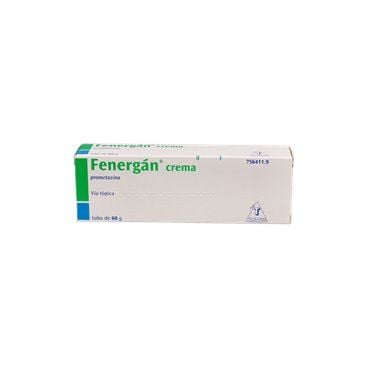Fenergan 20 Mg/G Cream 1 Tube 60 G
Indicated for allergic and contact dermatitis, burns, itching, insect bites, solar erythema and pernio, X-ray dermatitis.
Indicated for allergic and contact dermatitis, burns, itching, insect bites, solar erythema and pernio, X-ray dermatitis.
Fenergan (20 Mg / G Cream 1 Tube 60 G)
Promethazine
ACTION AND MECHANISM
- [HISTAMINERGIC ANTAGONIST (H-1)]. Promethazine is a phenothiazine derivative, which competitively, reversibly and nonspecifically blocks H1 receptors, reducing the systemic effects of histamine. It leads to vasoconstriction and decreased vascular permeability, reducing redness and edema associated with allergy. Partially mitigates symptoms associated with allergic processes such as eye redness or nasal congestion. It also produces a decrease in dermal itching.
PHARMACOKINETICS
- Absorption: At the recommended dose, only a very small amount of the active ingredients will be absorbed. The percutaneous absorption of promethazine has not been quantified and there are no specific data on its pharmacokinetics.
INDICATIONS
- [DERMATITIS] allergic and contact, [BURNS], [ITCHING], [INSECT BITES], [ERYTHEMA] solar and pernio, [DERMATITIS] by X-rays.
POSOLOGY
Apply the cream 3 or 4 times a day.
RULES FOR CORRECT ADMINISTRATION
Apply a thin layer and rub gently.
CONTRAINDICATIONS
- Hypersensitivity to any component of the drug. There may be cross reactions with other antihistamines, so it is not recommended to use any H1 antihistamine in patients who have presented hypersensitivity to any compound in the group. It is also not recommended to administer to patients with [ALLERGY TO PHENOTHIAZINE].
- Moist eczema and in infected dermatoses.
PRECAUTIONS
- Avoid its application on eroded, bleeding skin, with blisters, wounds or exudates, since there could be a percutaneous absorption producing systemic effects.
- Promethazine could lead to photosensitivity phenomena, so it is recommended not to sunbathe during treatment, and protect yourself with sun filters.
- [PORFIRIA]. H1 antihistamines have been associated with the appearance of porphyric outbreaks and are therefore not considered safe in these patients.
ADVICE TO THE PATIENT
- Antihistamine products should not be used in children without a prescription. It is also advised to avoid administration to large areas of skin.
- Avoid contact with the eyes and mucous membranes. Wash your hands well after application. If it accidentally gets into the eyes, rinse them with water.
- Avoid prolonged exposure to the sun of extensive treated skin areas.
INTERACTIONS
- It could enhance the photosensitizing effects of other active ingredients that give rise to photosensitivity reactions.
PREGNANCY
Animal safety : no data available.
Safety in Humans : It is not known whether promethazine can be absorbed topically. Adequate and well-controlled studies have not been conducted in humans, so the use of this medicine is only accepted if the potential benefits outweigh the possible risks and as long as there are no safer therapeutic alternatives.
Effects on Fertility : No specific studies have been performed in humans.
LACTATION
- It is not known whether topical promethazine is absorbed in sufficient quantity to be excreted in human milk, nor are its possible adverse effects on the nursing infant known.
ADVERSE REACTIONS
The side effects of promethazine are usually mild and transient, being more frequent during the first days of treatment. There is great interindividual variability with respect to the frequency and intensity of symptoms, especially affecting young children and the elderly. The most common adverse reactions are:
- Allergic / dermatological. Rarely, [HYPERSENSITIVITY REACTIONS] may occur after topical administration. [PHOTOSENSITIVITY REACTIONS] may also appear after intense exposure to sunlight, with [CONTACT DERMATITIS], [PRURITO], [EXANTEMATIC ERUPTIONS] and [ERYTHEMA].
In the event that the administration of promethazine cream has produced sensitization, the administration by another route of its active ingredient, promethazine, may produce cross-sensitization.
OVERDOSE
- Symptoms: accidental ingestion of a considerable amount can lead to the appearance of some of the symptoms of H1-antihistamine overdose, which are: CNS depression with drowsiness (mainly in adults), CNS stimulation and antimuscarinic effects (especially in children), including excitability, ataxia, hallucinations, tonic-clonic spasms, mydriasis, dry mouth, flushing, urinary retention, and fever. Hypotension and cardio-respiratory collapse may also appear.
- Treatment: there is no specific antidote for antihistamine overdose; the usual emergency resuscitation should be carried out, including activated charcoal, saline laxatives and cardio-respiratory support measures when necessary. Stimulants should not be administered. Vasopressors can be used to treat hypotension.



